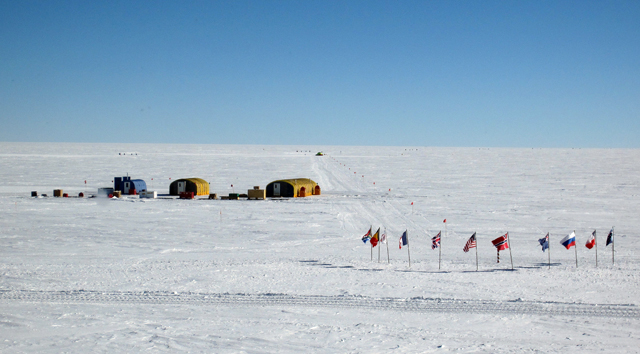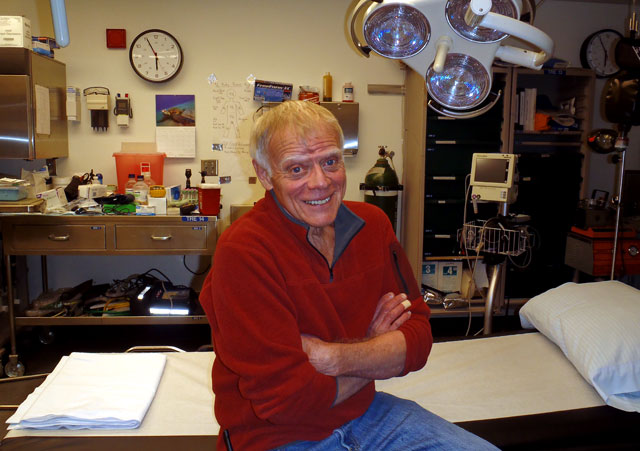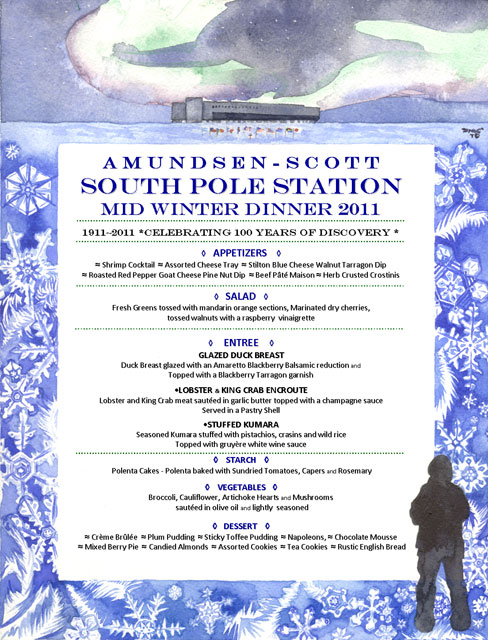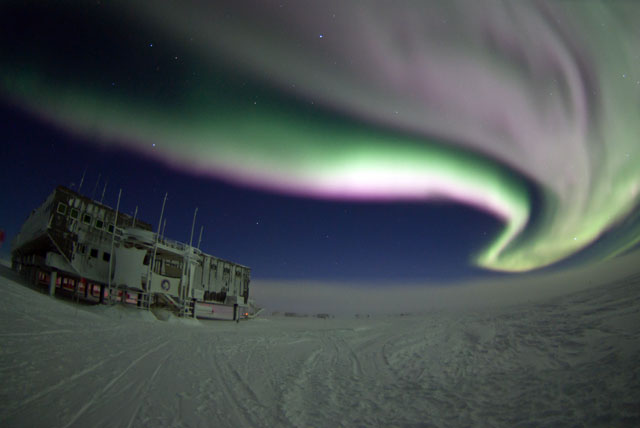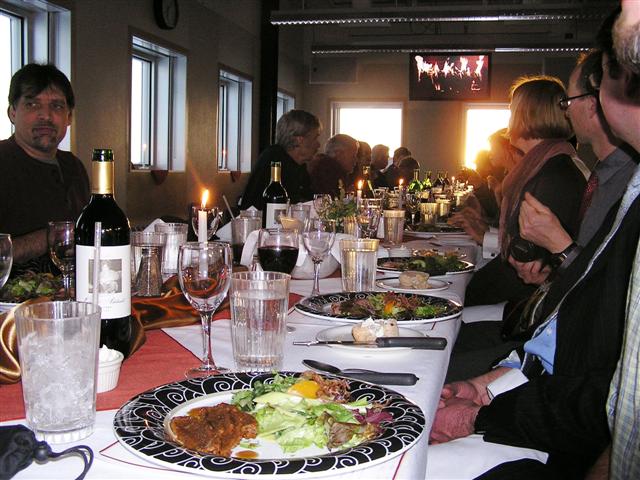|
South Pole Station Archives - 2011 Pole readies itself for Amundsen anniversaryPosted December 9, 2011
The summer season of 2011-2012 will be one to remember, with the 100-year anniversary of the arrival of Roald Amundsen and Robert Falcon Scott coming in the next few weeks. The South Pole Station A carpentry team from McMurdo Station The National Science Foundation Other preparations for the festive summer include new signage around the campus for visitors, groomed pedestrian corridors and the setup of a small camping area for those visitors requiring a night’s stay. Overland expeditions are currently racing across the continent from all corners, hoping to set new records, blazing their own trails or following in the footsteps of the great men who first found their way to South Pole. Outside of the centennial preparations, life at South Pole has been busy after a delayed start to the summer research season due to weather. One of the big projects for science this season will be several major upgrades for the South Pole Telescope (SPT) For the latest experiment, workers will need to install reflective shielding on the telescope. Without improving the shielding, which blocks interference from near the horizon, it would be difficult for the telescope to measure the gravitational wave signature from inflation. 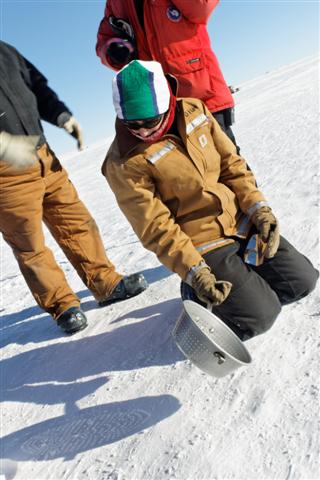
Photo Credit: Kiell Kosberg/Antarctic Photo Library
Polies use a kitchen strainer to observe the partial solar eclipse on Nov 25.
Despite the busy schedule, the station took pause for a couple of social events. Veteran’s Day saw a small group of about 30 convene at the Pole for a short, windy flag ceremony hosted by veteran Ron Carpenter on a brilliant, blue day. Thanksgiving started with a partial solar eclipse the evening before the festivities, with the science support folks hosting a safe viewing from the galley for many in the community, while others took to the outdoors to view this rare phenomenon. As the sun dimmed, it almost felt as if sunset was around the corner, but there are still months and months to go. After the eclipse, mad preparations continued for what was another successful Thanksgiving dinner for the entire station. In the short term, we look forward to the arrival of the South Pole Operation Traverse team any day now after their long trip from McMurdo. The tractor train hauls fuel and supplies about 1,000 miles between the two research stations. We are also preparing to welcome a party of high-ranking U.S. government officials here to survey the current state of the U.S. Antarctic Program, including the South Pole Station, with an eye for making long-term recommendations. The last visit by such a panel in the 1990s led to the construction of the new South Pole Station, which was dedicated in January 2008. Shortly after the Blue Ribbon Panel departs, we will welcome Norwegian Prime Minister Jens Stoltenberg Getting to the South Pole proves challenging in OctoberPosted November 11, 2011
Getting to the South Pole Station A pair of Basler BT-67 aircraft landed at the U.S. Antarctic Program's 
Photo Credit: Peter Rejcek
A Basler aircraft brought in the first summer crew to South Pole on Oct. 17.
One Basler had actually been scheduled to arrive at the station on Oct. 17, but with the first members of the incoming summer crew. However, that didn't happen until a week later on Oct. 24, again due to weather. It took another five days before the next Polies arrived at the South Pole, this time aboard an LC-130 aircraft, flown by the New York Air National Guard By the end of the month, the station population had climbed to 99, with some of the winter-over crew beginning their homeward journeys north. It was a record-breaking winter for some of the winter-over statistics kept by Antarctic historian Bill Spindler, who maintains the nongovernmental South Pole Station website Two people on station during the 2011 winter now hold the record for most winters at the South Pole with eight — Johan Booth and Steffen Richter. Close behind is Robert Schwarz, who is the only person with seven winters. A different sort of milestone will be marked this summer as the station commemorates the 100th anniversary of the famous Race to the South Pole between Norwegian Roald Amundsen and Briton Robert Falcon Scott. South Pole personnel rally together to support airdropPosted September 23, 2011
We began August with the first phase of twilight, heralding the beginning of the end of this winter season. By mid-August, there was a glow coming from the horizon. At times, it was difficult to see because of the moon’s brilliant glow, but the light noticeably increased daily. There were even a few days of faint twilight when the auroras made their final appearance for the winter. Enthusiasm in the station grew with the promise of light and the first meetings about preparations for the coming summer field season. On Sept. 5, we were given the all-clear by South Pole Station Although the solar glow was difficult to discern at that point, it was still quite refreshing to realize that soon the gentle light from the sun will head our way. The sun will finally break the horizon on Sept. 21. We are eager for the actual arrival of the sun to the skies, but also wish that the brilliant twilight would last longer. 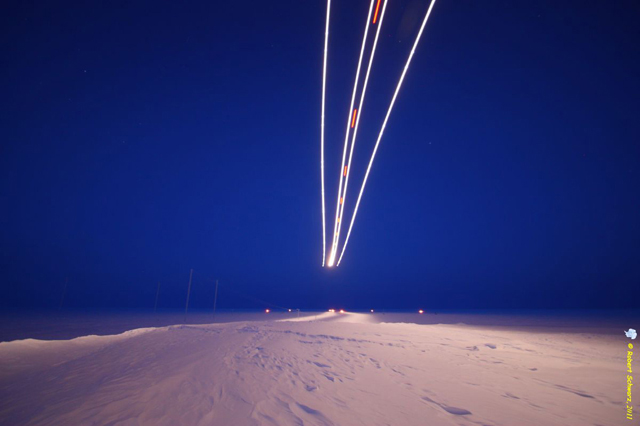
Photo Credit: Robert Schwarz
The lights from the Air Force C-17 leave streaks in the night sky over the South Pole.
At the end of August, we took part in an airdrop involving a U.S. Air Force Globemaster III C-17. This was an exhilarating event that helped wake us all out of our winter “toast” brain and rise to the challenge to quickly make all the ground preparations that were necessary for the airdrop. The whole station came together to make our portion of the airdrop a success so that we could receive essential medical supplies from New Zealand via the U.S. Air Force. The timing was perfect, as there were already planes on the continent to support the late winter operations for McMurdo Station We were also fortunate that there had been very few storms to create sastrugi, or rough snow sculpted by the wind, which would have increased the drop zone preparation time by the equipment operator. The winter weather also cooperated, with temperatures around minus 60 degrees Fahrenheit and 10-knot winds. In addition to the medicine, we also received mail and oranges. Aside from the excitement of the airdrop, the 49 winter-over Polies continue to be busy preparing the station for the summer, from writing end-of-season reports to shifting science support activities as the light changes to settling on our winter-over group photo location. All of the science projects continued to operate successfully in August, with routine troubleshooting and repair of hardware and software. Space weather projects have had a good observing season, with very clear skies this winter. In the dark sector, the astrophysics projects continued to run well while observing the cosmic microwave background or searching for elusive high-energy neutrinos. Air sampling and atmospheric monitoring instruments, surface-based and balloon-launched, continued to gather data in support of global climate studies at NOAA’s Atmospheric Research Observatory (ARO) Despite the physical and mental exhaustion that comes with a South Pole winter, we still spend time together outside of work. We have enjoyed a pool tournament, movie nights, Bingo, and weekly meals provided by various community members. We expect the first Basler aircraft to arrive in mid-October, leaving only one month until the conclusion of this winter season. South Pole slowly shifts out of winter darknessPosted August 19, 2011
Although July was the final month of “true” darkness at the South Pole We celebrated the Fourth of July with a barbeque and baseball movies in the galley, and also enjoyed Christmas in July with cookie decorating, a white elephant gift exchange and a Korean feast. 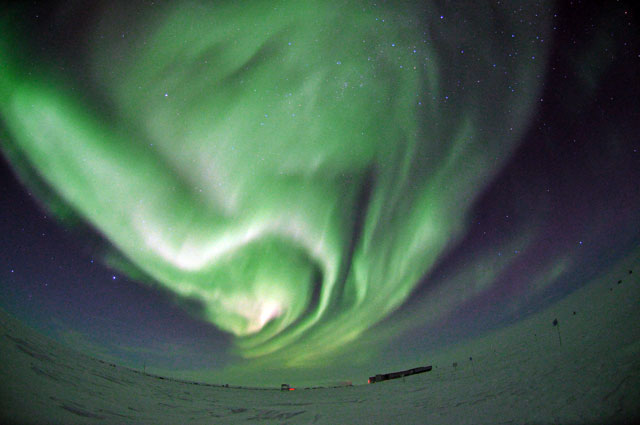
Photo Credit: Christy Schultz
Beautiful auroras still shimmer at the South Pole despite the slow return of the sun to the night sky.
The final weekend of the month stirred the station’s creative juices with the annual 48-Hour Antarctic Winter Film Festival, a filmmaking competition with participation from many of the research stations around the continent. [See previous article: At the movies.] It was a tremendous challenge to awaken our minds from day-to-day routines and create a film that fit the criteria of the festival within the 48-hour timeframe. One of our entries was influenced by our clinic and outstanding medical staff this winter, with a silly twist, of course, entitled, “Perspicacious: Popeye the Surgeon Man.” The second entry, competing in the free category, was “Attack of the Killer DOMS,” filmed in two episodes and influenced by IceCube The South Pole is quite fortunate to have two doctors this winter: Pat McGuire, who is an emergency room physician specializing in family medicine, and Jim Borden, a general surgeon. Jim also happens to be the most seasoned winter-over, at age 74, that the South Pole has seen. I hesitate to use the word old because it doesn’t apply to this fellow, as he said in this interview, “I like doing fun stuff with surgery.” Jim brings a lifetime of experience in this field. He has treated casualties of the Vietnam War and the current conflict in Afghanistan, trained surgeons in Laos, worked with the Peace Corp medical staff in Brazil, worked in Indonesia after the 2004 tsunami, spent time with a Lakota Sioux tribe in South Dakota and had a private practice in Fairbanks, Alaska, for 30 years. Jim was on his way to work at a community hospital in Zambia when he remembered that Raytheon offered medical positions in Antarctica, so he put his Africa plans on hold to spend the winter with us at the bottom of the world. Jim says what he will take away from this overall experience at the South Pole is the beauty of the landscape and skies, and his amazement with how well we are provided for in such a remote setting — and he has plenty of experience in this field! The station and the program have been incredibly fortunate to have both Jim and Pat here this winter. And Jim is not just a star in the medical clinic. He also starred in both of the Pole’s film festival submissions. South Pole midwinter feast is the best in a centuryPosted July 15, 2011
As the sun returns ever so slowly, making its way back to the south, we continue to relish the fantastic celestial shows and stellar jewels glimmering in the South Pole Station Our festivities focused around an amazing meal created by the galley staff that sought to incorporate some of the ingredients used by the first Antarctic winter-overs a century ago. Thankfully, we did not have to rely on dog or seal meat for our main dish choices, as the majority of the ingredients enjoyed both today and 100 years ago were desert offerings like plum pudding and the Napoleon. We began with a cocktail and appetizer hour, and truly enjoyed seeing each other in clothing other than our black and tan Carhartts. The galley was transformed into a beautiful dining room; volunteers had adorned the tables were with flowers from the greenhouse. Others helped to serve each course to their fellow Polies. The evening came to a close with a dance party where we could dance off our wonderful meal. The much-anticipated lunar eclipse on June 16 was met with overcast skies and, subsequently, disappointed spectators. Although we missed the splendor of the eclipse, we are frequently gifted with the auroras, which are often even visible while the moon is up. The magnificent deserts that accompanied the Midwinter meal were prepared by John Burkart. John is currently the galley “grublugger,” which means that he finds and delivers the galley staff’s weekly food orders, and maintains the inventory database. But John is best known for being the baker with the most consecutive summer seasons here at Pole. This past summer was his fourth summer, and he spent one winter as the baker in McMurdo during the winter of 2008. 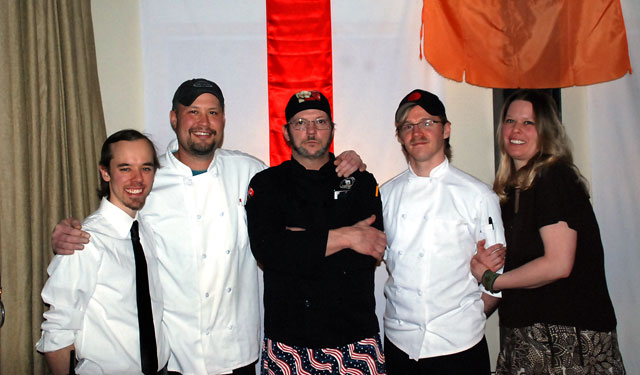
Photo Courtesy: Will Watkins
South Pole galley staff, from left, John Burkart, Bryan Denham, Will Watkins, Jeremy Gepner and Ashley Snyder.
John’s previous experience as a pastry chef in high-volume restaurants in Philadelphia has helped him to bring a level of proficiency and organization to the baking position, which is paramount. He says that obviously the greatest challenge is the altitude, which ranges roughly from 9,000 to 12,000 feet, depending on changes in ambient pressure. Each recipe must be tweaked, and some simply refuse to comply. John says he was initially surprised by the variety of ingredients that he has to work with, and enjoys trying out his tasty creations on the community and being able to receive immediate feedback. John also volunteers many hours each week with community members who are interested in learning how to use the professional appliances in the kitchen, so that we each have the opportunity to share our favorite dishes with one another. What keeps John returning to the South Pole is the freedom to test his creativity in this challenging environment — but mostly he enjoys the sense of community. Night sky offers treats and challenges at the South PolePosted June 24, 2011
May is the month when “Polies” are settled into their work routine, which includes dealing with constant darkness. For many of us wintering here at the South Pole Station Deep into the winter now, recreation becomes an important element for the community. Each night and day off at least one activity is offered to get people out of their routines. Although some enjoy the Pole winter because it grants them time to savor the solitude of our seclusion, having the opportunity to spend time with others in a non-work setting is essential. 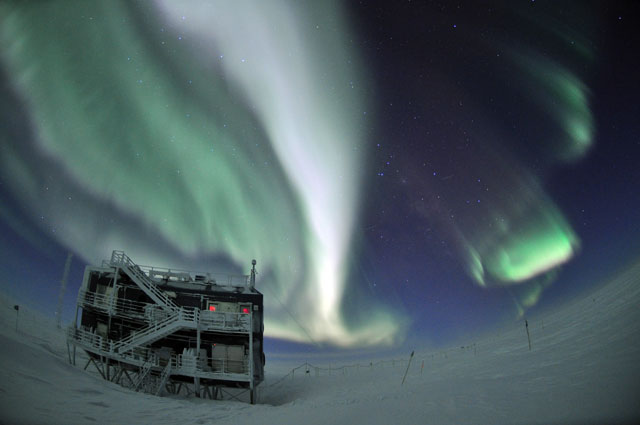
Photo Credit: Christy Schultz
An aurora shimmers over NOAA's Atmospheric Research Observatory at the South Pole.
One highlight was the seventh annual 5K, which here involves doing 18 laps up and down the stairs in the station — in full costume. There were eight participants overall, including two individual competitors and two relay teams of three members each. Weeks Heist won the male and the costume categories; Ashley Snyder won the female category. There were many spectators in the galley, as it served as the headquarters and relay switch-point. Holly Allin and Weeks Heist shared travelogues last month. These offer the audience a sense of adventure and introduce ideas for future travel. Other recreation opportunities include drive-in movie nights, craft night, sports in the gym, bingo, pub trivia, and at least one dance party a month. Susan MacGregor, our growth chamber technician, shared an interesting bit of information concerning an original design for the indoor greenhouse. One of the initial proposals for providing carbon dioxide to the growth chamber was to pipe in CO2 from our berthing units, where the levels rise to over 900 parts per million nightly. Currently, we use cylinders to provide the CO2 for production of our coveted “freshies.” The growth chamber yielded 156 pounds of produce in May. Robert Schwarz, SPUD telescope winter-over, completed his multi-week lecture series on astronomy in May, while Freija Descamps, IceCube We experienced a record in South Pole weather last month, with May 2011 being the coldest May since the Navy began keeping records in 1957. The average temperature was -62.6C/-80.7F. The previous record was from 1989. On May 27, the temperature reached -75.2 C/-103.4F, which allowed for the first meeting of the 300 Club for the winter. Membership requirements involve sitting in a sauna at 200 degrees F and then making a brief visit to the geographic pole while the temperature is below -100 degrees. Our senior meteorologist, Tim Markle, is on his third winter, and he has observed the weather here for three summer seasons as well. Tim spent four years observing weather on Mount Washington in New Hampshire, which until recently was touted as the windiest place on the planet. Tim brings a wealth of experience to Pole’s meteorology department, and even with all of the technology that he has at his disposal, he says that his eyes are still his best tool for observations. During the summer, a typical observation takes just a few moments, but because of the lack of light, the winter observations can take up to 20 minutes, as Tim’s eyes adjust to the darkness. He then uses the minute variances in the moon and star light to determine cloud cover. Tim says that although the South Pole weather is not extraordinary, with the exception of the extreme cold, he finds the greatest challenge here the lack of landmarks and landforms, which are typically important factors in weather observation. The challenges and the wonders of the South Pole night for Tim and the rest of us will continue until September, when the sun returns to the sky for 24 hours of summer. South Pole night sky a highlight of winter isolationPosted May 20, 2011
True darkness has set upon the South Pole Station The world’s southern-most Easter bunny was also busy, as everyone awoke on the holiday to find individualized baskets of treats; it was a wonderful sentiment and a pleasant surprise on Sunday morning. Our head chef worked on his day off and prepared a feast similar to that of his mother's Easter meals of the past, which was appreciated by all. On other days when the kitchen staff is off, community members have stepped in to provide fantastic meals for everyone — a welcome bit of comfort that we can all share with one another. The 24-hour night sky has offered another kind of comfort, as the celestial display is beyond compare! Alert observers will notify the rest of the station by radio when a heavenly aurora appears. Folks don their extreme cold weather gear and head to the closest door. Once outside, it’s common to hear yelling and clapping from the spectators, since there is little else creating sound. The absence of the moon has allowed us to become acquainted with the stars of the southern hemisphere, as most of us hail from the north. Robert Schwarz, winter-over for the Small Polarimeter Upgrade for DASI (SPUD) project It is quite generous for those involved in South Pole science to share their work with those of us who support the research. It contributes to the sense of community. All of the science projects are successfully operating, now that the remaining light-sensitive upper atmospheric and geospace science experiments have been activated. 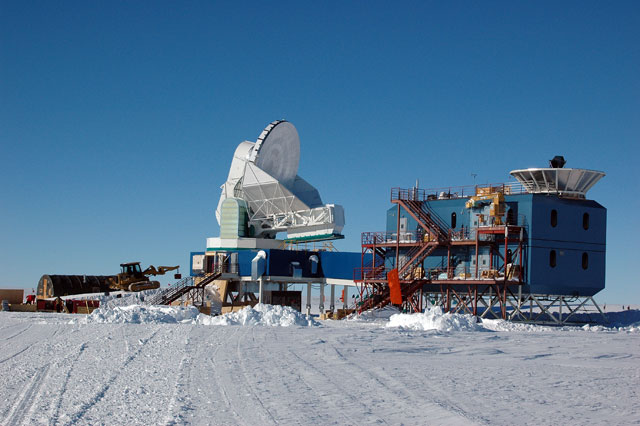
Photo Credit: Peter Rejcek
The South Pole Telescope, left, and Dark Sector Lab during the 2010-11 summer season.
In the dark sector, the astrophysics projects continue to run well, while observing the cosmic microwave background or searching for elusive neutrinos. Once the sun set in late March for six long months, windows of the station and outlying building were covered to prohibit interior station light from contaminating the data of light-sensitive projects. Minimizing outdoor light also provides the best environment for allowing one’s eyes to adjust to the natural ambient light, enhancing safety while walking to remote sites and maximizing the visual beauty of the night skies and Antarctic plateau. And those walks have been getting colder. The average temperature in April was minus 76 degrees Fahrenheit, bottoming out at minus 95.1 on April 18. Some days have been extremely windy, as well, with a record wind gust of 38 miles per hour on April 23, breaking a 41-year record. Sun sets at the South Pole StationPosted April 1, 2011
On Feb. 15, the last New York Air National Guard Due to the extreme snow drifting the station experiences during the winter months, most of the tasks revolve around decreasing the effects that the drifting will have on the next summer field season. Personnel who don’t have particular outdoor assignments are quick to volunteer their time and energy to assist with winterization. As the quickly dropping temperatures prevent the use of most heavy equipment, it is obviously a race to complete these duties with speed before all but one of the machines goes into hibernation. 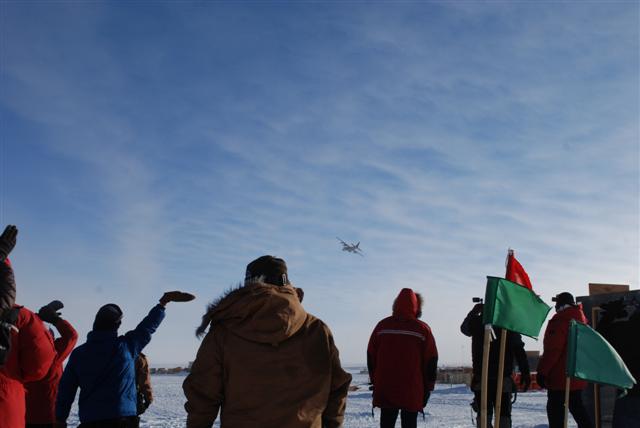
Photo Credit: Renee-Nicole Douceur
Polies wave farewell to the last flight of the 2010-11 summer field season.
All of the mobile buildings are moved to a location far away from the station, known as “the end of the world.” Hundreds of flags are placed to designate paths to outbuildings and to outline the corners of structures. The hose that carries the fuel for the station that is pumped off the LC-130s and into the fuel arch is rolled up and stored for the winter. The winter consumable material, like food, is collected and brought into the cargo facility in hopes of decreasing the trips to the outdoor storage areas in the dark winter months. The official sunset occurred on March 23 at 2:54 p.m., although this does not account for our elevation above sea level or refractive atmospheric conditions. There are three periods of twilight; the final will end on May 12, ushering in darkness and auroras. The windows of the station are covered to prevent light pollution from contaminating research experiments. One of our resident astronomers, Robert Schwarz, is offering an astronomy class to prepare the first time winter-overs for the splendor the heavens will soon produce. On Feb. 25, the first celebration of Commedia dell’Arte Day, a form of theatre that began in Italy in the mid-16th century, happened at the South Pole. Handmade masks were supplied from Antonio Fava in Italy. It was the first time that the play was performed on all seven continents. The kitchen staff traditionally prepares a special meal to commemorate the sunset. The meal included filet mignon, lobster Newburg, duck breast salad, and handmade chocolates. The dining area was transformed into a formal dining room. It provided an opportunity for everyone to dress in something other than cold weather clothing, and relax in the dwindling sunlight. The winter-over crew donated $10,000 — matched dollar by dollar by British Petroleum — to the Red Cross of New Zealand Science roundupWe have several major projects in the field of astrophysics, including BICEP2 and SPUD, which are both telescopes for the tell-tale signals of inflation, a theory that holds the universe expanded exponentially fractions of a second after the Big Bang. [See related article: Inflation at South Pole.] The IceCube Neutrino Observatory There were two new instruments recently installed on the roof of the Martin A. Pomerantz Observatory — the Gattini-UV South Pole Camera and the High Elevation Antarctic Terahertz (HEAT) telescope for Dome A and Ridge A. Both are operating normally and collecting data. The winter meteorological staff collected weather data late in the season to support several flights traveling off the continent for the winter. February was the third warmest one on record, led by 1986 and 1958. South Pole Station goes into winter hibernationPosted March 11, 2011
The last flight of the summer field season at South Pole Station 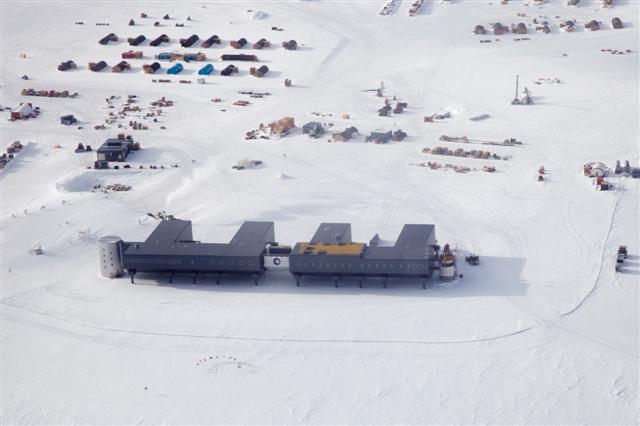
Photo Credit: Rickey Gates/Antarctic Photo Library
An aerial of the South Pole Station toward the end of the 2010-11 season.
Station closing activities included the removal of the airfield skiway marker flags, including the approach flags; installation of flagl ines to all regularly visited off-site buildings; removal of the fuel line from the aircraft area to the station storage tanks; clean-up and winterization of the Jamesways (summer living quarters); movement of personnel into winter quarters and much more. Most of the science projects are fully operational as the sun rapidly drops toward the horizon to finally disappear for six months on the southern hemisphere’s autumnal equinox, March 23, when the remaining upper atmospheric physics projects will then be activated. February was the third warmest February on record, with an average temperature of minus 37.2 degrees Celsius. The only years in which the month of February was warmer was 1986 and 1958. Some of the above information came from the South Pole Station science report by winter-over science leader, J. Dana Hrubes, who is back for his sixth winter on the South Pole Telescope |
Home /
Around the Continent /
South Pole Station Archives - 2011
"News about the USAP, the Ice, and the People"



For USAP Participants |
For The Public |
For Researchers and EducatorsContact UsU.S. National Science FoundationOffice of Polar Programs Geosciences Directorate 2415 Eisenhower Avenue, Suite W7100 Alexandria, VA 22314 Sign up for the NSF Office of Polar Programs newsletter and events. Feedback Form |

